
Fr: Bernache du Canada
Ang: Canada Goose
All: Kanadagans
Esp: Barnacla canadiense grande
Ita: Oca canadese
Nd: Atlantische Canadese Gans
Sd: kanadagås
Photographers:
John Anderson
John Anderson Photo Galleries
Steve Garvie
RAINBIRDER Photo galleries & Flickr Rainbirder
Tom Grey
Tom Grey's Bird Pictures & Tom Grey's Bird Pictures 2
René Lortie
René Lortie photographe & Galeries d'oiseaux sur Pbase
Tom Merigan
Tom Merigan’s Photo Galleries
Otto Plantema
Trips around the world
Nicole Bouglouan
PHOTOGRAPHIC RAMBLE
Text by Nicole Bouglouan
Sources:
HANDBOOK OF THE BIRDS OF THE WORLD vol 1 by Josep del Hoyo-Andrew Elliot-Jordi Sargatal - Lynx Edicions - ISBN: 8487334105
BIRDS OF THE GREAT BASIN – by Fred A. Ryser - Univ of Nevada Pr -ISBN: 0874170796
FIELD GUIDE TO THE BIRDS OF NORTH AMERICA - National Geographic Society -ISBN: 0792274512
GUIDE DES CANARDS, DES OIES ET DES CYGNES – de Steve Madge - Delachaux et Niestlé - ISBN: 2603013769
L’ENCYCLOPEDIE MONDIALE DES OISEAUX - Dr Christopher M. Perrins - BORDAS - ISBN: 2040185607
THE COMPLETE BOOK OF BRITISH BIRDS – Written by “Royal Society for the Protection of Birds” experts - Préface de Magnus Magnusson - Michael Cady- Rob Hume Editors - ISBN: 0749509112
THE HANDBOOK OF BIRD IDENTIFICATION FOR EUROPE AND THE WESTERN PALEARCTIC by Mark Beaman, Steve Madge - C. Helm - ISBN: 0713639601
All About Birds (Cornell Lab of Ornithology)
Animal Diversity Web (University of Michigan Museum of Zoology)
Bird Web (Seattle Audubon Society)
SORA Searchable Ornithological Research Archive (Blair O. Wolf)
Wikipedia, the free encyclopaedia
What Bird-The ultimate Bird Guide (Mitchell Waite)
Canada Goose
Branta canadensis
Anseriformes Order – Anatidae Family
INTRODUCTION:
The Canada Goose is a member of the tribe Anatini, within the large family Anatidae. The genus Branta contains the geese with largely dark plumage, different from the grey geese of genus Anser.
The Canada Goose is a North American species that breeds from the Arctic tundra to southern regions, from the Great Basin in Nevada, to N Florida on the east coast. This species occurs year-round in the south of the breeding range. However, the northernmost breeding populations move S to spend the winter between California and South Carolina, and even in N Mexico.
The population has increased in some areas after serious decline by the early 20th century, due to habitat loss and overhunting.
The Canada Goose has been introduced in Europe, and these populations do not migrate, except those of the northern parts of the European range. It is important to point out that these geese are also found naturally on the Kamchatka Peninsula in E Siberia, and E China.
This species has been introduced in New Zealand in 1905 as gamebird. In this country, they are considered pests by farmers and are not legally protected for this reason, involving the loss of numerous geese by hunting.
The Canada Goose is not globally threatened and currently evaluated as Least Concern.

DESCRIPTION OF THE BIRD:
Biometrics: (depending on each subspecies)
Length: 55-110 cm
Wingspan: 122-183 cm
Weight: 1310-6500 g
The Canada Goose is a large goose with black head and long neck, and conspicuous white patch on the cheek, extending under the chin and forming a “chin strap”.
The upperparts are largely brown, with pale edges to feathers, forming indistinct bars. Lower back, rump and tail are black, contrasting with the white V on tail’s base. On the upperwing, the flight feathers are darker.
The underparts are paler, with whitish breast and yellowish flanks. Lower belly and undertail-coverts are white; the underwing is dark brown.
Bill, legs and webbed feet are black. The eyes are dark brown.
Male and female are similar in plumage, but the male is larger than the female.
The juvenile resembles adults, but it is duller overall, with brownish head and neck, and pale brownish wash on cheek patches.

SUBSPECIES AND RANGE:
The Canada Goose has seven subspecies which differ mainly in size, proportions and coloration. The southern races are larger with large bills, whereas the northern subspecies are smaller, with small bills, but with long wings (because they are migratory).
B.c. occidentalis breeds in Copper R delta in Gulf of Alaska and Prince William Sound, S Alaska. It winters on coasts from British Columbia S to Oregon. This race is the darkest and weights 3300 grams.
B.c. fulva occurs on coastal S Alaska and S British Columbia. It is the largest of the dark forms.
B.c. parvipes breeds in C interior Alaska E throughout inland Canada to NW Hudson Bay. It winters in SC USA. This one is smaller, but with long body and shorter neck, medium-sized bill and rounded head.
B.c. moffitti breeds in SW and S Canada and W USA. It winters in NW USA, S to NW Mexico.
B.c. maxima was formerly in the Great Plains, and has been reintroduced in Mississippi flyway. This race is largest and palest, and weights 5030 grams.
B.c. interior breeds in C and E Canada and NE USA. It winters in E USA. This one is the largest of relevant taxa, with long neck and long bill.
B.c. Canadensis (described above) breeds in SE Canada and NE USA. It winters in E USA.
The Canada Goose has been introduced in Britain, NW and C Europe (canadensis) and in New Zealand (maxima).
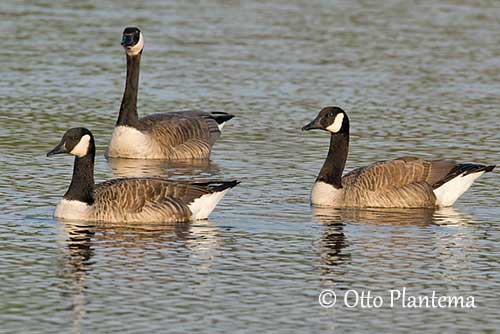
HABITAT:
The Canada Goose breeds in open or forested areas near water, from tundra to semi-desert. The migrating flocks feed in wetlands, grasslands and cultivated fields, but always near water. This species is visible up to 2000 metres of elevation in N Mexico in winter.
CALLS AND SONGS: SOUNDS BY XENO-CANTO
The Canada Goose utters a deep, musical “honk-a-honk” (larger races), while the smaller geese give a rapid, high cackle. The contact call among pair’s members or in family groups is a quiet growling “urr, ur-eit”. In territorial defense, both adults give loud hisses while stretching the neck forwards with wide open bill. About 13 different calls have been identified.
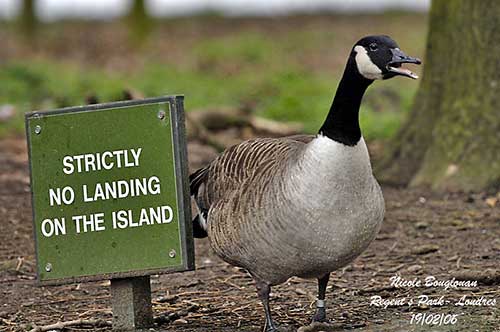
BEHAVIOUR IN THE WILD:
The Canada Goose feeds on a variety of aquatic plants by eating green parts, roots, stems, leaves and fruits. It is also a terrestrial grazer and often feeds on land, taking clover, grasses and other plant species, grain and corn. It also consumes seaweed, and may occasionally take some insects, mollusks, crustaceans or small fish.
This goose feeds mainly by grazing in grassy areas, whereas in water, it dips the head below the surface or performs upending.
The Canada Goose is primarily monogamous and usually pairs for life, although a dead mate will be replaced. The mates remain together all year round. The courtship displays start on the wintering grounds, and continues during the return migration. The pair- bonding is initiated by a young male pursuing a female. The male also fights over the female, pinching her with the bill and beating her with the wings.
The “triumph ceremony” is an important step in courtship. The male calls loudly while approaching a chosen female with wide open bill hold near the ground, usually after a victorious fight with another male. The neck is outstretched while weaving to and fro. If the female accepts, she may join the male and they perform a mutual display. They are pair-bonded when the female follows the male in flight.
These displays are also used in territorial defense, or against predator that threatens the mate or the chicks.
The copulation usually occurs in the water, after some displays with mates facing each other, dipping both head and neck in and out of the water. Once paired, the birds raise their breast up, hold their heads high and extend their wings while facing each other and calling.
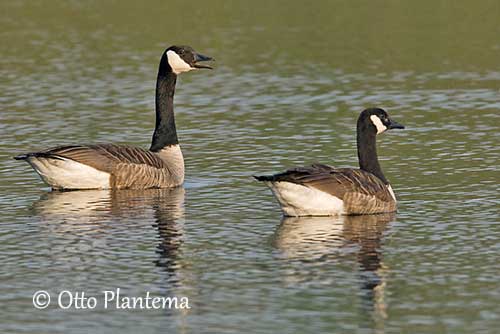
The Canada Goose may migrate S after breeding, as the northernmost populations do, but numerous birds remain all year round in the southern part of their breeding range.
The flocks usually migrate in V-formation, but also in J-formation or in diagonal lines. The conspicuous black-and-white tail pattern aids visual contact for the following geese during the flight.
The Canada Goose has strong, direct flight with powerful, deep wingbeats.
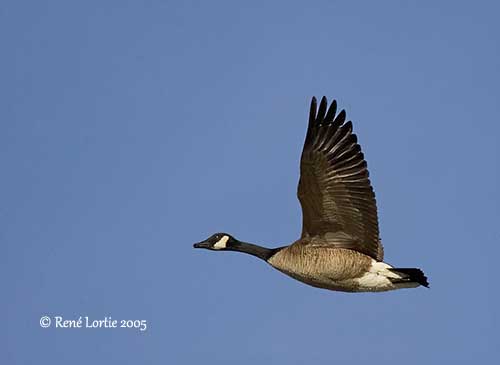
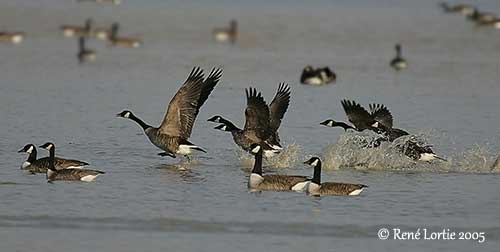
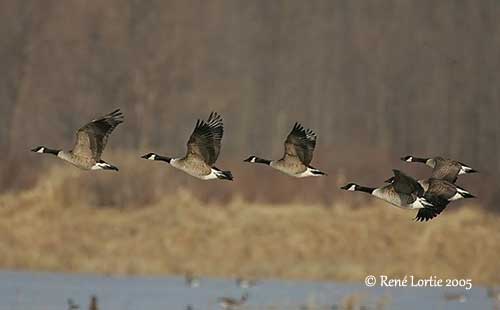
REPRODUCTION OF THIS SPECIES:
The breeding season varies depending on the range, but it usually takes place in spring. The Canada Goose nests in single pairs or in colonies.
The nest-site is chosen by the female, often on slightly elevated dry ground but near water, allowing good visibility all around. However, the Canada Goose may also nest on cliff ledges, in trees and on artificial structures. The female builds a shallow depression, a bowl made with sticks, grass, weeds and moss, and lined with down.
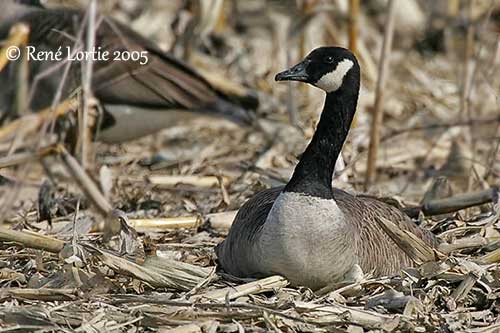
She lays 4-7, sometimes 2-11 creamy-white eggs, becoming progressively stained. She incubates during 25-28 days, while the male remains on watch nearby. She usually leaves the nest several times a day, but the eggs are covered with the downy lining, making them invisible on the ground. The male accompanies its mate while she feeds, drinks, bathes or preens.
At hatching, the chicks have olive-brown down above and yellow below, and a stripe across the eye. They are precocial and after one night at nest, they leave the site with their parents and reach a suitable area where they will find food, cover and roosting places. They are able to feed themselves. They may form crèches with some adults to guard them.
After some weeks, the adults start the postnuptial molt. They are flightless during 5-6 weeks during which they escape predators by going out into the water or underwater.
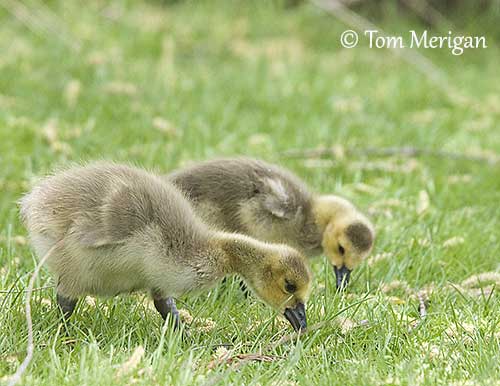
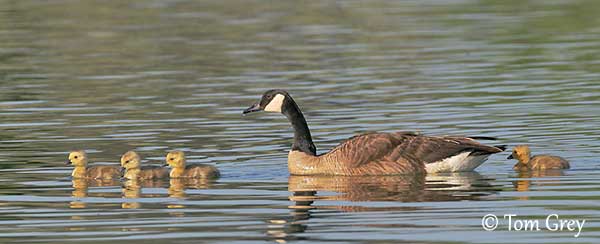
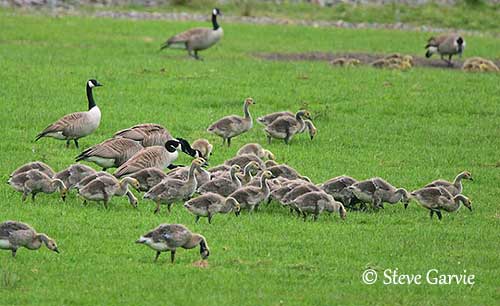
The Canada Goose hybridizes with the Greylag Goose, the Snow Goose, the Pink-footed Goose and the Barnacle Goose. They hybridize primarily in captivity, but it is thought to be less common in the wild.
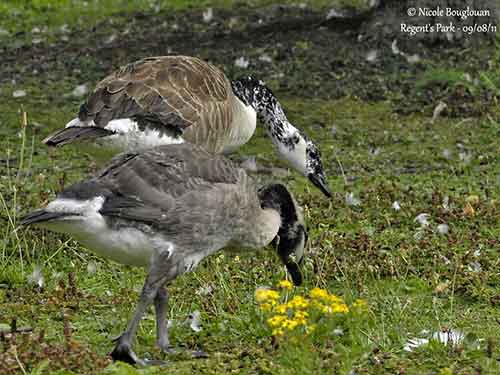
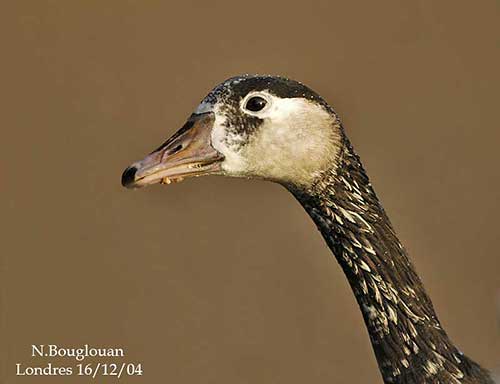
PROTECTION / THREATS / STATUS:
The Canada Goose is often a common resident of urban lakes and parks in many areas, and this species responds well to management on wildlife refuges.
Eggs and chicks are taken by several predators such as coyotes, arctic fox, northern raccoon, red fox, large gulls, Common Raven, American Crow, Carrion Crow (in Europe), Bald Eagle, Golden Eagle and bears.
The Canada Goose is a common target of hunters and mainly in its native range. Hunting occurs during the hunting season, but they are often killed without permits too, because they are seen as pests in some urban areas, and in cultivated areas in New Zealand where they are not legally protected and killed all year round.
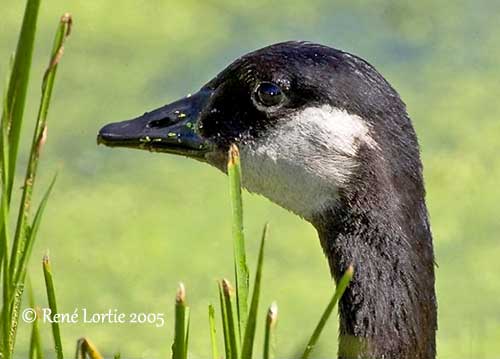
Despite hunting and other direct natural mortality, the population is increasing and the range is expanding. The total north-American population was estimated to number 4,2 million/5,6 million individuals in 2012. There were 174,000 individuals in Britain in 2002, between 35,000 and 40,000 individuals in New Zealand following recent estimate, and 90,000 individuals in Scandinavia in 2000/2010.
The Canada Goose is currently evaluated as Least Concern.